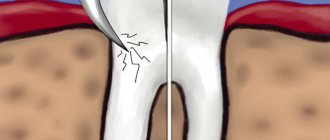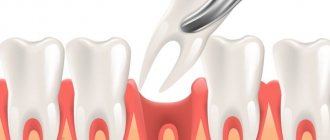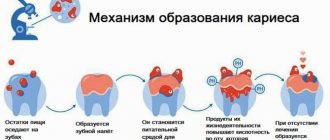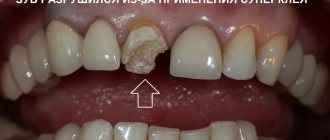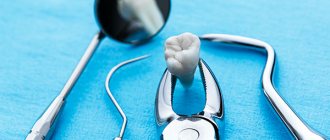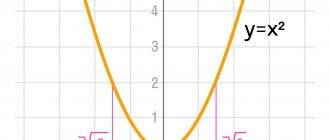Indications and contraindications for molar tooth extraction
Reasons for removing a molar tooth may be:
- purulent periostitis;
- abscess;
- phlegmon;
- large tumor in the tooth area;
- purulent periodontal disease;
- the presence of a cyst in the area of the diseased tooth;
- exposed pulp;
- longitudinal tooth fracture;
- critical tooth decay;
- critical tooth curvature;
- disease of the dental bone tissue;
- sinusitis.
The following reasons are contraindications to the removal of molars:
- acute heart diseases;
- acute viral diseases;
- flu;
- angina;
- renal failure;
- pancreatitis;
- hepatitis;
- acute diseases of the nervous system;
- oncological diseases
- initial and final stages of pregnancy;
- stomatitis;
- gingivitis
- general degeneration of the body;
- alcohol poisoning.
Molar removal technology
Before proceeding with the removal of a molar, the doctor must make sure that there is no curvature of the roots. For this, an x-ray is taken. If the roots are not bent, the patient is given an anesthetic injection. After 10 minutes, the tooth can be removed.
First, the dentist carefully separates the gum from the body of the tooth. Then he grabs the tooth with pliers and begins to swing it and rotate it at the same time. After several such manipulations, the doctor pulls the tooth out of the alveoli.
In this sequence, both the upper and lower root teeth are removed. However, it is somewhat more difficult to grasp the upper molars with forceps.
Sometimes, when removing a molar, the doctor must first cut it into two or three parts and then pull out each part separately. This usually happens when the roots are bent.
In case of severe curvature of the roots, when they intertwine with the roots of neighboring teeth, removal must be done in fragments and under general anesthesia. In this case, the doctor completely exposes the gum around the diseased tooth.
If there is a cyst in the area of a diseased molar, the doctor is required to be highly qualified. This removal is done under both local and general anesthesia.
Two days after the removal of a molar, the patient must visit the dentist again to take an x-ray. This is necessary to ensure that all tooth roots have been removed.
Tools: forceps, drill, elevators
| Name | Process description | Application |
| Forceps | With their help, a part of the tooth is taken that protrudes on both sides above the edge of the alveolus. To do this, it is first necessary to separate the periodontium from the root surface or peel off the mucous membrane from the boundaries of the alveoli. | To carry out manipulations on the paired jaw, a tool with straight ends is used. Forceps with wide bayonet-shaped blades are used to remove the roots of any teeth located on the upper jaw. The lower jaw is processed using wedge-shaped forceps. |
| Elevator | The initial stage of surgical resolution is carried out by performing a syndesmotomy. Afterwards, an elevator is inserted into the cavity between the walls of the periodontal socket and the root body itself. One of the main indications for its use is the deep location of the root in the alveolus, which makes it impossible to extract it with forceps. | Roots in the upper jaw that are abnormally located outside the dentition or are a hidden part of the third molar in the lower jaw are removed using a direct elevator. The roots of the teeth in the lower jaw are removed using an angular elevator. A Lecluse elevator with a peaked working part is used to remove the third large lower molar. |
| Drill | It involves removing the outer wall of the alveoli with a bur, followed by extracting the root with forceps. | It is used only for removing the root of a single-rooted tooth or if the roots of a multi-rooted tooth are located separately. This method is indispensable for extracting the root after a fracture of its apical section, significant curvature, hypercementosis, or abnormalities in shape and position. The drill is also used when the root is located deep in the alveolar process, or when it is completely covered with bone tissue and mucous membrane. |
Forceps Elevators Drill
Removing a tooth root is a complex dental procedure that requires high professionalism from a dental surgeon. The correct choice of tools for its extraction is the key to a successful operation.
Is it painful to remove molars?
Today, only older people remember the terrible pain during the removal of molars. Nowadays, the quality of painkillers is so high that the patient does not feel pain at all, even with difficult removal. At the same time, after the anesthesia wears off, pain, of course, occurs, but it is quite tolerable and depends on how much the gum under the tooth was disturbed.
If the pain is still severe, then the dentist recommends taking a painkiller tablet. The same analgin successfully dulls pain for a long time.
In rare cases, the patient may experience throbbing and increasing pain. This annoying phenomenon occurs due to inflammation of the socket. If measures are not taken quickly, the tissue begins to fester in the hole. This process can be suppressed with drug treatment, but sometimes you have to open the gum and clean the hole from pus.
Possible complications
Among the most common complications that occur during tooth root removal are the following:
- dislocation of the jaw, if the doctor has little experience;
- inflammatory process in the hole;
- penetration of bone particles into it;
- damage to teeth located next to the one being removed;
- allergy to anesthesia;
- heavy bleeding.
If you do not skimp on dental services and contact an experienced specialist, as well as follow all medical recommendations, then the risk of complications is minimized.
Removal of molars during pregnancy
Let us say right away that any surgical intervention during pregnancy is extremely undesirable. If a molar tooth hurts at this time, then ideally it would be best to simply heal it. Unfortunately, sometimes this is no longer possible and the diseased tooth has to be removed.
It is highly undesirable to remove molars in the first and last months of pregnancy. It is at this time that the fetus is most vulnerable.
If it is possible to postpone the removal of a molar until the birth of the child, then this is exactly what should be done.
Under no circumstances should you hide your pregnancy from your dentist. On the contrary, this should be said immediately. In this case, the doctor will select a harmless anesthetic that will not cross the placental barrier.
If a pregnant woman is facing a complex molar tooth extraction, then this should only be done in a hospital setting. After removal, the patient should be under medical supervision for at least two to three days. This is due to the fact that very often, after the removal of a molar, pregnant women experience a sharp increase in body temperature, and this is extremely harmful for the fetus.
How painful is the manipulation?
High-quality anesthesia makes the procedure painless.
Many patients are interested in whether it hurts to pull out the roots of teeth? The duration of the operation depends on the clinical picture of the condition of the tooth and the root itself. Its location also plays a significant role. On average, with the high professionalism of the dental surgeon, such an operation lasts for half an hour. But, if a complex wisdom tooth root extraction is carried out, then such manipulation may take 90 minutes or more.
In modern dentistry, when extracting a tooth root, strong anesthetic drugs are used, under the influence of which pain is not felt at all. They are selected for any pain threshold. The effect of such drugs is sufficient not only for the operation itself, but also for two hours after it. Also, depending on the complexity of the manipulation, general anesthesia may be performed.
Important! The selection of anesthesia should be carried out exclusively by a doctor, taking into account the patient’s health status and age category, as well as the complexity of the operation.
Molar tooth extraction in children
Unfortunately, young children often develop diseases in both their primary and permanent molars. Worse, it is not always possible to heal them. Dentists remove permanent teeth for children only when there is no way to save them.
Primary molars are both treated and removed. If a permanent tooth begins to grow under a baby molar, then the baby tooth is always removed, since it interferes with the normal formation of the permanent tooth.
At the same time, dentists never agree to premature removal of baby molars. Such teeth are sure to heal. If you remove a baby tooth ahead of schedule, then the baby will develop a crooked bite.
There are situations when a child’s molar tooth must be removed. Such situations include:
- molar root cyst;
- presence of granuloma;
- inflammation of the tooth root;
- inflammation of the nerve of the lower jaw;
- severe destruction of the integrity of the tooth.
Indications
Experts highlight the following series of main indications:
- Tooth fractures of various etiologies.
- Development of inflammatory processes.
- Loss of tooth integrity (it fell apart, broke, rotted).
- Third level of root mobility.
- Abnormal locations of decayed teeth.
- Manifestation of characteristic symptoms of inflammation.
Important! Extraction of the root of a tooth that has collapsed is a mandatory procedure. It is the main breeding ground for infection in the oral cavity. The presence of rotten roots at the top provokes the formation of granulomas and cysts, which can subsequently develop into a malignant tumor.
Is it possible to remove a molar tooth yourself?
Trying to remove a molar tooth yourself is extremely dangerous. The only exception is very severe tooth looseness. It should be borne in mind that complete removal even in this situation will not work. You will simply break off the body of the tooth from the root, and nothing more. In any case, after such an independent removal, you need to visit a dentist, who will determine what should be done next. Sometimes an artificial tooth is installed at the root, and it can last for more than one year. If the root has defects, then it has to be removed.
There are situations when you have to remove a child’s very loose baby tooth at home. In this case, you should thoroughly brush the baby’s teeth and disinfect the oral cavity. Then you should wrap your fingers in sterile gauze, loosen the tooth thoroughly, and only then try to pull it out. If this was not possible on the second attempt, then the child must be taken to the dental clinic in any case.
If you have successfully removed the tooth from the socket, then you must firmly place a gauze swab in the socket and leave it there for 30 - 40 minutes. In the next two hours, the child should not be allowed to eat or drink.
Even if the removal was successful, the baby still needs to be shown to the dentist. This is the only way to protect your child from possible complications.
Features of tooth root extraction in different jaws
There are slight differences in the methods and types of instruments used for manipulation on different jaws.
On the top, bayonet-shaped forceps are used to extract molars. C-shaped dental pliers are used to extract incisors and canines. For these purposes, rotational movements are carried out with pliers, which ensures minimal damage to the periodontal tissues. If it is impossible to extract the tooth root with dental pliers, then a drill is used.
The rejected root is removed after preliminary sawing the bottom of the tooth cavity. After using a drill with a ball-shaped tip, the necessary cavity is created in the inter-root commissure for longitudinal sawing of the bottom of the tooth with a furssor drill. Next, in the prepared cavity, using an elevator and bayonet-shaped dental pliers, the palatal root is dislocated.
The procedure for removing roots on the lower jaw is much simpler. For these purposes, as a rule, dental pliers with curves along the edge and with thin and narrow cheeks are used. Extraction of the roots of wisdom teeth is carried out by surgeons with the additional use of an elevator.
